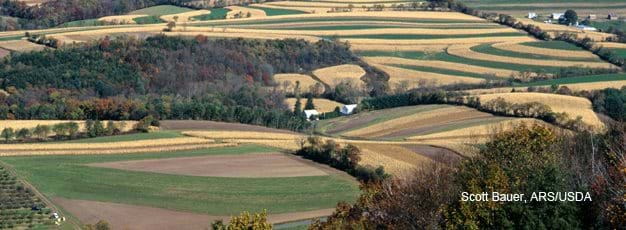Can Commodity Program Payments Encourage Better Nutrient Management?

Since 1985, farmers’ and ranchers’ eligibility for commodity program payments and other Federal, agriculture-related payments has been contingent on their meeting certain soil and wetland conservation standards. On highly erodible cropland, for example, producers must apply an approved soil conservation system to maintain eligibility for government payments. ERS research indicates that this “conservation compliance” requirement could be responsible for up to 25 percent of the 1.2-billion-ton reduction in annual cropland soil erosion between 1982 and 1997.
Nutrient runoff from agriculture has been identified as a major contributor to water quality problems, and manure management issues have received considerable attention. However, the U.S. Geological Survey (USGS) estimates that commercial fertilizer applications are responsible for a substantial share of nutrient runoff, particularly nitrogen. In areas where USGS has found the highest level of nitrogen loads to surface water, roughly half of all nitrogen runoff is estimated to come from commercial fertilizer applications.
Can commodity program payments be further leveraged to obtain better nutrient management? The answer depends on the extent to which areas receiving these payments coincide with the location of nutrient runoff problems and whether payments are large enough to offset the cost of reducing runoff. ERS estimates that more than 80 percent of cropland acres with high or very high nitrogen runoff potential are on farms that receive commodity program payments. Moreover, the highest payments appear to flow to producers in areas where nitrogen runoff potential is greatest. Similar relationships are observed between commodity program payments and potential for phosphorus runoff to surface water and nitrogen leaching to groundwater.
Are commodity program payments large enough to cover the costs of nutrient management and still provide the intended income support? The answer varies among farms. Where nitrogen runoff potential is highest, annual commodity program payments ranged from about $42 to more than $100 per cropland acre. Environmental Quality Incentive Program (EQIP) payments are the best available estimates of producers’ costs for implementing a nutrient management plan. Half of all annual nonlivestock EQIP payments (paid for up to 3 years) are $5 per acre or less, while 95 percent are $15 per acre or less. Buffer practices, such as filter strips, may be cost-effective for reducing surface runoff because they occupy only about 2.5 percent of a field. A grass filter strip costs an estimated $2.70 per cropland acre, on average, although costs vary considerably.
For many—but not all—crop farms with very high nutrient runoff potential, the cost of measures designed to reduce nutrient runoff would be modest compared with their commodity program payments. Moreover, additional nutrient management requirements would reduce net income support to producers by the cost of applying nutrient management practices or conservation buffers. On the whole, however, a nutrient management requirement might prove as effective in reducing nutrient runoff from cropland as conservation compliance has been in reducing erosion.
Environmental Compliance in U.S. Agricultural Policy: Past Performance and Future Potential, by Roger Claassen, Vince Breneman, Shawn Bucholtz, Andrea Cattaneo, Robert Johansson, and Mitch Morehart, USDA, Economic Research Service, May 2004
Conservation Programs, by Kate Binzen Fuller, USDA, Economic Research Service, October 2024
Environmental Interactions with Agricultural Production, ERS, May 2010


